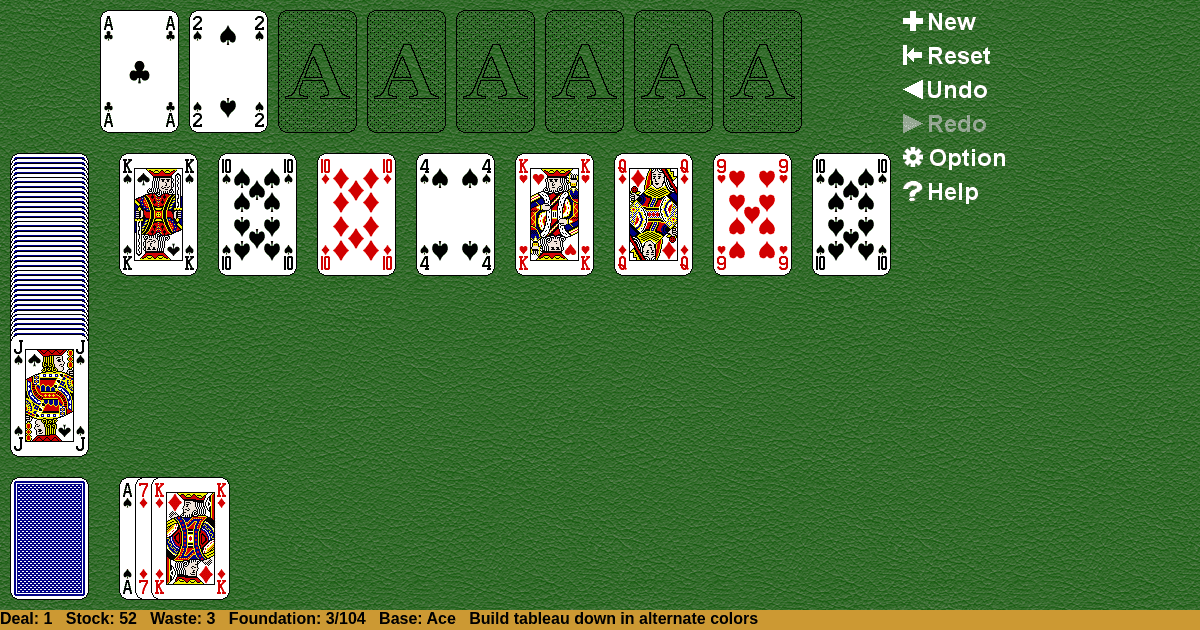Demon
Home |
How to play |
FAQ |
About
How to play Demon?
Game Objective:
The primary goal in Demon Solitaire (also known as Canfield in the US) is to move all cards from the tableau, reserve (also called the demon), and stock to the foundation piles, building each foundation up in sequence by suit until the deck is fully organized.
Setup & Layout:
- Deck: Use a standard 52-card deck with no jokers.
- Reserve ("Demon") Pile: Deal 13 cards face-down to form the reserve pile. Turn the top card of this pile face-up; this card is available for play.
- Foundations: Deal one card face-up to start the first of four foundation piles. The remaining three foundation piles will be started as soon as cards of the same rank as the base card become available.
- Tableau: Deal one card face-up to each of four tableau piles, arranged in a row beneath the foundations.
- Stock: The remaining cards form the stock pile, which is placed face-down.
- Waste Pile: As cards are drawn from the stock, they are placed face-up in a waste pile.
Key Play Areas:
- Reserve (Demon): 13-card pile, only the top card is face-up and available.
- Foundations: Four piles, built up by suit starting from the base card.
- Tableau: Four piles, cards are face-up and built down in alternating colors.
- Stock: Face-down pile for drawing cards.
- Waste: Face-up pile created from stock draws.
Demon Solitaire Rules:
- Foundations:
- Build up by suit, starting from the base card (e.g., if the base is 7, build 7-8-9-10-J-Q-K-A-2-3-4-5-6).
- Cards wrap around from King to Ace if necessary.
- Tableau:
- Build down in rank, alternating colors (e.g., red 7 on black 8).
- Sequences can be moved as a unit if they maintain alternating color and descending order.
- Reserve (Demon):
- Only the top face-up card can be played to either the tableau or the foundations.
- Stock and Waste:
- Cards are drawn from the stock in packets of three (or one at a time, depending on the variant), placed face-up on the waste pile.
- Only the top card of the waste pile is available for play.
- Movement:
- Cards can be moved between tableau piles, to the foundations, or from the reserve as allowed by the building rules.
- When a tableau pile is emptied, it must be filled immediately with the top card from the reserve; if the reserve is empty, fill it with the top card from the waste pile.
Gameplay:
Turn Sequence:
Play any available moves among tableau, reserve, and foundations.
Draw three cards from the stock and place them face-up on the waste pile.
Use the top card of the waste pile if it can be played to the tableau or foundations.
When a tableau pile is emptied, fill it with the top card from the reserve; if the reserve is empty, fill it with the top card from the waste pile.
Repeat drawing from the stock and making moves until no further moves are possible or all cards are in the foundations.
Redeals:
When the stock is exhausted, turn the waste pile over to form a new stock. This can be done unlimited times in most versions, though some restrict the number of redeals.
No More Moves:
If no legal moves are available and the stock cannot be redealt, the game ends in a loss.
Winning & Losing Conditions:
- Win: The game is won when all 52 cards are moved to the foundations, completing each suit in sequence.
- Loss: The game is lost or considered unwinnable if no further legal moves can be made and the stock cannot be redealt.
Special Rules & Edge Cases:
- Filling Empty Tableau Spaces:
- Any empty tableau pile must be filled immediately with the top card from the reserve (demon). If the reserve is empty, use the top card from the waste pile.
- Sequence Movement:
- Entire sequences in the tableau (maintaining descending order and alternating colors) can be moved as a unit between tableau piles.
- Foundation Base Card:
- All foundation piles must start with a card of the same rank as the initial base card.
- Stock Draw Variation:
- Standard rule is to draw three cards at a time from the stock, but some variants allow drawing one at a time for easier play.
- Redeal Limitations:
- Most modern rules allow unlimited redeals, but some traditional rules limit the number of times the waste can be recycled into the stock.
- Wrapping:
- Both tableau and foundation sequences can "wrap" around the corner (King to Ace or Ace to King) as needed.
This guide covers the canonical single-player version of Demon Solitaire (Canfield), as played with one standard deck. For multiplayer "Racing Demon" or "Nerts" variants, rules differ and are not included here.




























































